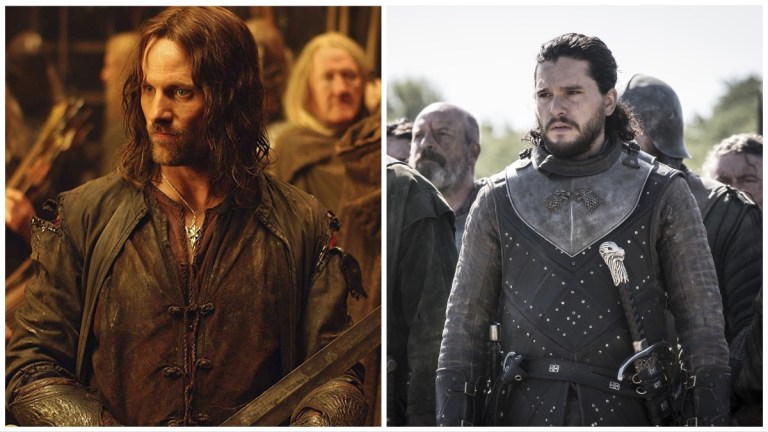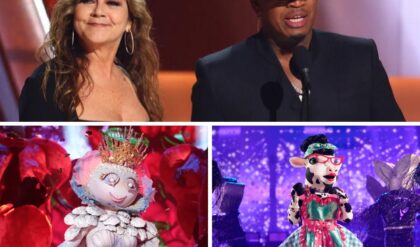George R.R. Martin learned many lessons from J.R.R. Tolkien and the similarities between Lord of the Rings and Game of Thrones reflect that.

It is pretty well known among fans that George R. R. Martin, the author of A Song of Ice and Fire books upon which Game of Thrones is based, has a double-edged relationship with J.R.R. Tolkien and The Lord of the Rings. On the one hand, like every other fantasy author of the 20th and 21st centuries, Martin has been heavily influenced by Tolkien and is more than happy to say so. He has spoken many times about his love of The Lord of the Rings and how he thinks Tolkien did what he wanted to do brilliantly, and the debt he and other fantasy authors owe Tolkien.
On the other hand, Martin has also talked about the ways he writes differently from Tolkien, and the questions he likes to ask about the story presented in The Lord of the Rings. In 2014, for example, he told Rolling Stone that when Tolkien gives his story a happily ever after in which Aragorn rules wisely for a hundred years, Martin wants to know, but how? What is his tax policy? And what did he do with all the Orcs still living in the mountains? “Real history,” Martin observed, is “not that simple.” (Tolkien, incidentally, did start a sequel set shortly after Aragorn’s death but gave it up as it was too dark and miserable for his tastes – so he was not unaware of these issues himself).
Martin’s world of Westeros, Essos, and the various lands surrounding them is a place that is both heavily influenced by Tolkien and his Middle-earth, and at the same time it is a place and a story that reacts against some of Tolkien’s themes and story types. So how exactly does that come through in Martin’s stories?
The Similarity in Names
We can start in the most obvious place, with the names of people and places. We should not read too much into this, as sometimes Martin uses well known names for characters just because it amuses him to do so. There are, for example, three generations of Tullys in Fire & Blood (the book House of the Dragon is based on) who are all named after Muppets (Grover, Elmo, Kermit, and Oscar). That probably does not mean anything too significant, though if we see more of Oscar in the planned Fire & Blood Part 2 we might expect him to be rather grumpy.
And so Martin’s use of Tolkien’s title “Evenstar” probably does not mean too much. In Tolkien, the title is a very significant name used for Arwen, the “evening star” of the Elves, who gives up her immortality to marry Aragorn and is one of the last Elves in Middle-earth by the time she dies. In A Song of Ice and Fire, the title belongs to Brienne’s father as it is a hereditary title of the Lord of Tarth. This may come to have special significance later in the story, but so far it just seems to exist to contrast Arwen’s legendary beauty with poor Brienne’s more homely looks.
There is another Tolkien-inspired character name that is a lot more significant, though – Samwell Tarly. Samwell’s name is an echo of Samwise Gamgee from The Lord of the Rings. On the surface, their characters are not very similar – Samwell is noble-born and claims to be a coward (though he isn’t really), while Samwise is working class and extremely brave from the start (and unlike Samwell, Samwise is never described as fat, either – that detail comes from the Peter Jackson films).
But underneath that, the two characters play a similar role in the two stories. The Lord of the Rings may have started out as a story about Frodo, but by the time it was finished, as Tolkien himself said in his letters, the “chief hero” of the story was not Frodo but Sam. Although he is working as a gardener at the beginning of the story, it is also Sam who gathers together the history of the War of the Ring. After Bilbo and Frodo, having written the Red Book of Westmarch (i.e. The Hobbit and The Lord of the Rings), leave for the Undying Lands, it is Sam who compiles the Red Book and adds the Appendices and makes copies for his children. (A Song of Ice and Fire also has a ‘Red Book,’ but it is a history of the fighting pits of Meereen, so that one is another case of just taking the name and the basic concept).
In A Song of Ice and Fire, Samwell is bookish from the start, and by the end of the fifth (and still most recent) book A Dance with Dragons, he is on his way to Oldtown to become a maester, one of the order of scholars responsible for, among other things, keeping and writing the histories of the Seven Kingdoms. The prequel novel Fire & Blood is “written” by an earlier maester, Archmaester Gyldayn – presumably Samwell will eventually fill this role and record the history of the many wars of the Song of Ice and Fire, as he does in the TV series, and just as Samwise preserved the history of the War of the Ring.
The Silmarillion and The GRRMarillion
That is another thing Tolkien and Martin’s novels have in common. Both like to provide an in-universe book that their novels are supposedly a reprint of. This is most obvious in Fire & Blood, which is a brilliant imitation of popular history books complete with contradictory primary sources and lots of opinions from the “author” thrown in. In an interview with Dan Jones published at the back of the book, Martin says he calls Fire & Blood “The GRRMarillion,” a play on Tolkien’s The Silmarillion.
The Silmarillion is the history – or, perhaps, mythology – of the First Age of Middle-earth. Tolkien had been creating this mythology long before he wrote The Hobbit. It had all started with his story of Beren and Lúthien, inspired by his own meeting with his wife Edith, and with his love of invented languages, and grew from there, with The Hobbit being put into the same invented universe only after it had been mostly written. He had been trying to write up The Silmarillion for publication for years, and was still working on it only a few weeks before his death in 1973. It was finally compiled, edited and published four years later by his son and literary executor Christopher Tolkien.
The Silmarillion, like Fire & Blood, is an imaginary history of an invented world going back to a time before the main story takes place. Although Tolkien did not go as far as Martin in constructing it just like a history book, it does read like one. And although he does not include specific contradictory primary sources like Martin’s jester Mushroom and cleric Septon Eustace, he does imply that this is a written version of a collection of oral histories, using phrases like “it is said among the Elves that…” or “it was said afterwards among the Eldar that…” More of his unfinished notes, drafts, and stories about Middle-earth, also edited by Christopher, were published in 1980 as Unfinished Tales, and this does introduce contradictory versions of the same story, as Tolkien changed his mind all the time and no two drafts were ever quite the same. It’s easy to see why Martin calls Fire & Blood “The GRRMarillion.”
Lord of the Rings and Game of Thrones Have Recurring Themes
There are other recurring themes in Martin’s stories that draw on Tolkien as well. Martin told Dan Jones that he “followed the template of Tolkien” in developing the plot of the story of A Game of Thrones, starting with everyone except Daenerys in Winterfell and then spreading them all out across his invented world, just as The Lord of the Rings starts in the Shire and then spreads its characters out across Middle-earth.
Both stories also deal with war and trauma in remarkably similar ways despite the very different experiences of their writers. Tolkien was a veteran of the First World War who had suffered trench fever while on active service and lost many friends and comrades, and his son Christopher served with the RAF in World War II. Martin was a conscientious objector during the Vietnam War (though he has said he would have fought the Nazis in World War II had he been alive – it was the specific war he objected to) and did alternative service with Volunteers in Service to America. Both, from their different perspectives, write about the horrors of war.
Interestingly, Martin writes in much more gory detail about battles and injuries than Tolkien does. But both write about trauma. Frodo is clearly traumatized by his experiences in the War of the Ring, as well as suffering from ongoing physical pain from the old injury to his shoulder from Weathertop, and that is partly why he chooses to leave Middle-earth all together at the end of The Lord of the Rings. Martin’s characters display a tendency to try to take on new identities, to deal with the trauma they have experienced. Theon has the identity of Reek forced on him by Ramsey Bolton, Sansa (in the books) is encouraged to take on the identity of Alayne Stone by Littlefinger, but Arya, who has already been in disguise since her father’s death, seeks out the Faceless Men herself, who encourage her to abandon her identity and personality entirely. All three are dealing with immense trauma, and the process of coming back to themselves and their own identities will presumably be part of how they deal with that trauma in the last two books of the series.
Even, somewhat surprisingly, Martin’s favorite recurring theme of incest appears in Tolkien as well. In Tolkien’s story of Túrin Turambar, first told in The Silmarillion and later expanded into The Children of Húrin, the hero Túrin accidentally marries his sister Nienor without realizing she is his sister. We should admit that this probably has more to do with both authors being inspired by the same medieval legends, especially Thomas Malory’s 15th century Le Morte d’Arthur, in which King Arthur sleeps with his half-sister Morgause and fathers Mordred without realizing she is his sister, rather than Martin taking this theme from Tolkien. Tolkien’s Túrin also takes inspiration from mythological characters like the ancient Greek Oedipus, and the fact that, like Oedipus and Arthur, the incest is accidental is central to Tolkien’s story, unlike the repeated, deliberate, and enthusiastic incestuous relationships of many of Martin’s characters. If Martin’s books follow a similar trajectory to the TV adaptation, though, we may see a more Tolkien-esque example of incest, assuming that as in the show Jon Snow and Daenerys Targaryen sleep together before finding out that they are, in fact, aunt and nephew.
The Return of the Kings
Jon Snow is another character influenced by a broad combination of history, legend, mythology, and Tolkien. Buried underneath Martin’s love of blood and gore and sex scenes, there are also some really traditional tales to be found in A Song of Ice and Fire. There is a scene in A Storm of Swords, for example, in which a white knight rescues a virginal damsel in distress from a bear pit. The knight is pretty dirty by this time and is missing a hand, and he rescues her by persuading her captors to let her go, and the damsel is a trained warrior doing her best to defend herself before he shows up, but the core of the story is still the same.
And although Martin disapproves of the simplistic medieval idea that a good king is needed for the land as a whole to prosper, at the heart of his Song of Ice and Fire is a very Tolkien-esque story about a returning monarch. Strip out the politicking, the backstabbing, and the petty wars, and you have a story about a bunch of lords fighting over a throne while that classic fantasy character, a boy who is actually the “rightful” king but does not even know it himself, sits in the background, quietly getting on with the business of protecting the land from a bigger threat (the White Walkers). Although much of the narrative seems to question the idea of a “rightful” king and whether that even has any meaning, especially considering the Targaryens came to the throne by violent conquest, the idea of a “rightful” king who is needed, in a magical way, by the kingdom was re-introduced only last year in season 1 of House of the Dragon.
In a scene that did not appear in the book but that was written by Martin himself, King Viserys I Targaryen tells his daughter and heir Rhaenyra that Aegon the Conqueror dreamed “the end of the world of men” would “begin with a terrible winter” and that “if the world of men is to survive, a Targaryen must be seated on the Iron Throne.” He shows Rhaenyra a catspaw dagger (the same one Littlefinger would use to start a war centuries later) and, just like Gandalf throws the One Ring into Frodo’s fire to show the inscription on it, when the dagger heats up an inscription appears on it which reads, “From my blood comes the prince that was promised, and his will be the song of ice and fire.”
Book readers have a lot of different theories about the various prophecies in A Song of Ice and Fire and who they might or might not refer to, but this seems like it pretty clearly refers to either Jon Snow (secret son of Rhaegar Targaryen, as revealed on the TV show and as is almost certainly also the case in the books) or Daenerys Targaryen. (We know, book readers, it could be Young Griff, but we don’t have room to get into that right now). It’s either that, or the world is doomed. And so what we are actually looking at across this whole fantastical saga, with all its blood and guts and gore and misery, is, in the end… The Return of the King.





